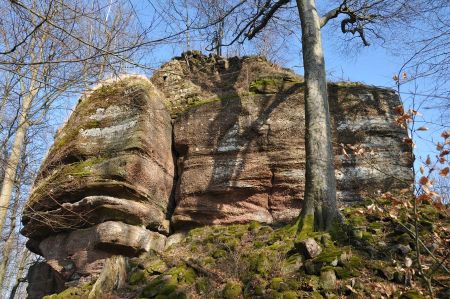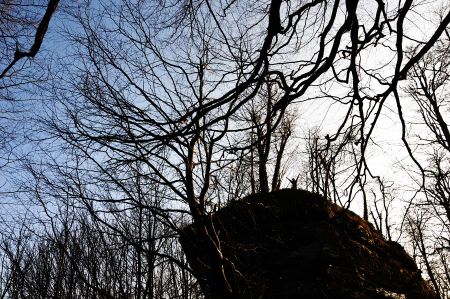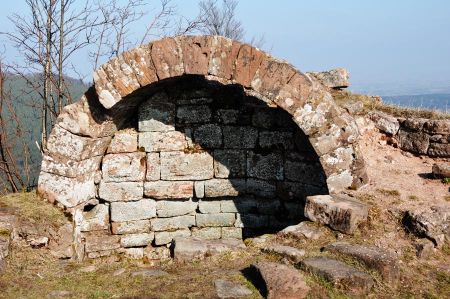Ochsenstein Castle near Reinhardsmunster
- Written by Portal Editor
Even today the view from the window shows a blue, cloudless sky and at the breakfast table we can already see the anticipation in Patrick: another wonderful day for paragliding. So breakfast is done quickly, the equipment is already in the vehicle anyway and off you go.
This time we will accompany him to a different launch site, which is above Reinhardsmunster in the Vosges. But then we will hike through the forest to the Ochsenstein Castle. The associated Ochsenberg is a 584 meter high ridge in the northern Vosges in the French department of Lower Alsace.
After about 45 kilometers, first on the A 351 in the direction of Handschuhheim, then turning left at Singrist onto the D 117 to Reinhardsmunster, we reach the Vosges mountain range, which is so popular with many paragliders because of the good thermals. Arrived quite early, there are only three other pilots on site. We'll just wait for Patrick to start and then we'll be on our way. Half an hour later we already notice ten of the colorful umbrellas in the sky above the Ochsenberg.
Adventurous way up to the ruins of Ochsenstein
 First it goes on the asphalt road to the forester's house past a paddock before the forest path to the Ochsenstein is reached. Now an initially quite wide forest path leads up to the Ochsenberg through beautiful deciduous forest. The path gets narrower and alternates between pine and beech forest until you finally reach the ridge at 584 meters.
First it goes on the asphalt road to the forester's house past a paddock before the forest path to the Ochsenstein is reached. Now an initially quite wide forest path leads up to the Ochsenberg through beautiful deciduous forest. The path gets narrower and alternates between pine and beech forest until you finally reach the ridge at 584 meters.
As a typical castle complex of the 12th century, the Ochsenstein Fortress is also a typical example of so-called rock castles, whose planners and creators already integrated the surrounding terrain into parts of the building for use as spatial boundaries, i.e. walls, during the planning phase. Natural rock formations and added pieces of wall alternate. The entire mountain consists of red sandstone rocks that were formed millions of years ago. The traces of sediment with pebbles enclosed in them are clearly visible in many places. Sometimes the embedded pebbles appear like toy marbles stuck in the sand.
Like many other castles, the Ochsenstein Fortress was built to defend the passage between Alsace and Lorraine. However, the Ochsenstein has three castles that are close together, which is quite unusual. Unfortunately, only the remains of the walls of the once proud castle complex are left today. The first rock in the south was used by the Groß Ochsenstein Castle, also known as the Large Castle, followed by Klein Ochsenstein and on the third rock Wachelheim. All three castles are closely connected by stone steps carved into the rock. We reach the ruins of the main castle after a few steps, which still shows most of the remains of the wall. You can still clearly see a half-shell tower, several of the beam holes for receiving the ceiling beams that were once there, remains of the bering, remains of a gatehouse and pieces of wall that were possibly once used as a kennel. The second rock, to which a relatively steep ladder leads today, which ends in a through tunnel to the platform, still shows the foundations of residential buildings, and a dome of a rainwater collection system with a cistern underneath can also be clearly seen. Here the beginnings of the once existing ribbed vaulting are clearly visible.
Please always enter the entire castle complex with particular caution, as some of the slopes and overhangs are not fixed and can hardly be seen from deep down.
Count Bourcard von Ochsenstein
 The first historical mention of Count Bourcard von Ochsenstein goes back to the signature in a document from the year 1187, so today one can assume that the castle had already existed at that time. When Bourcard's successor, Otto I, fell ill a few years later in 1217, he divided his land holdings between his sons. Two of his sons took over the lands while the other three sons received the castle complex. Otto II, Otto I's eldest son, received Ochsenstein Castle at his father's request, which was already well known at the time under the name "Der Fels" due to the knights and burghers who guarded it. Of course, the farms (serfs) in the area were also transferred. The second son, Eberhard, received Wachelheim Castle, the third castle complex on the ridge. Conrad, the third son, received the Greifenstein fortress, but had to grant the privileges of inhabiting the castle to the nobles. Otto I survived his illness and established close ties with the Habsburgs until his death in 1241.
The first historical mention of Count Bourcard von Ochsenstein goes back to the signature in a document from the year 1187, so today one can assume that the castle had already existed at that time. When Bourcard's successor, Otto I, fell ill a few years later in 1217, he divided his land holdings between his sons. Two of his sons took over the lands while the other three sons received the castle complex. Otto II, Otto I's eldest son, received Ochsenstein Castle at his father's request, which was already well known at the time under the name "Der Fels" due to the knights and burghers who guarded it. Of course, the farms (serfs) in the area were also transferred. The second son, Eberhard, received Wachelheim Castle, the third castle complex on the ridge. Conrad, the third son, received the Greifenstein fortress, but had to grant the privileges of inhabiting the castle to the nobles. Otto I survived his illness and established close ties with the Habsburgs until his death in 1241.
The hiking trail up to Ochsenstein Castle is a great experience for every nature lover and probably not entirely unknown to many. We met some hikers who also wanted to visit other castles in the northern Vosges region on a circular route. Also a paradise for mountain bikers, as confirmed by a small group of bikers. All paths are excellently marked, so that you can plan a good route in advance.
Geographical location 48° 40' 58" N, 7° 18' 1" E
Please read as well:
The Old Town Hall of Rottweil – live experienced history
Danube spring or Danube creek in Donaueschingen
